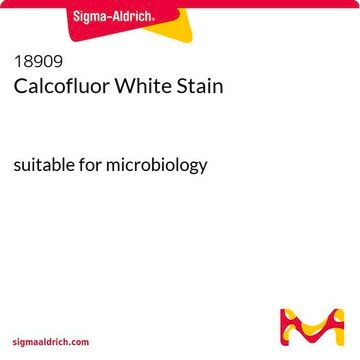This product has not been tested for any specific application, including in vivo use. Suitability would have to be determined experimentally by the end user. Historical information suggests that a concentration of 0.5% Evans Blue in PBS at pH 7.4 has been used successfully in staining tissue sections. This concentration may also be effective starting point for in vivo applications. Please refer to available literature for additional information.
Wichtige Dokumente
E2129
Evans-Blau
Dye content ≥75 %, Powder
Synonym(e):
Direct Blue 53
Größe auswählen
Größe auswählen
About This Item
Empfohlene Produkte
Produktbezeichnung
Evans-Blau, Dye content ≥75 %
Form
powder
Qualitätsniveau
Zusammensetzung
Dye content, ≥75%
Methode(n)
titration: suitable
Anwendung(en)
diagnostic assay manufacturing
hematology
histology
Lagertemp.
room temp
SMILES String
[Na+].[Na+].[Na+].[Na+].Cc1cc(ccc1\N=N\c2ccc3c(cc(c(N)c3c2O)S([O-])(=O)=O)S([O-])(=O)=O)-c4ccc(\N=N\c5ccc6c(cc(c(N)c6c5O)S([O-])(=O)=O)S([O-])(=O)=O)c(C)c4
InChI
1S/C34H28N6O14S4.4Na/c1-15-11-17(3-7-21(15)37-39-23-9-5-19-25(55(43,44)45)13-27(57(49,50)51)31(35)29(19)33(23)41)18-4-8-22(16(2)12-18)38-40-24-10-6-20-26(56(46,47)48)14-28(58(52,53)54)32(36)30(20)34(24)42;;;;/h3-14,41-42H,35-36H2,1-2H3,(H,43,44,45)(H,46,47,48)(H,49,50,51)(H,52,53,54);;;;/q;4*+1/p-4/b39-37+,40-38+;;;;
InChIKey
ATNOAWAQFYGAOY-GPTZEZBUSA-J
Angaben zum Gen
human ... PTPN1(5770) , PTPRF(5792)
Suchen Sie nach ähnlichen Produkten? Aufrufen Leitfaden zum Produktvergleich
Allgemeine Beschreibung
Anwendung
Biochem./physiol. Wirkung
Signalwort
Danger
H-Sätze
Gefahreneinstufungen
Carc. 1B
Lagerklassenschlüssel
6.1C - Combustible acute toxic Cat.3 / toxic compounds or compounds which causing chronic effects
WGK
WGK 3
Flammpunkt (°F)
Not applicable
Flammpunkt (°C)
Not applicable
Hier finden Sie alle aktuellen Versionen:
Besitzen Sie dieses Produkt bereits?
In der Dokumentenbibliothek finden Sie die Dokumentation zu den Produkten, die Sie kürzlich erworben haben.
-
What amount and concentration should I use Evans-Blaun injecting it into the ear skin of a mouse to see Evans-Blue in the draining Lymphnodes afterwards?
1 answer-
Helpful?
-
-
What is the stability of the E2129 solution once prepared?
1 answer-
The stability of the solution will depend on whether the solutions are sterile filtered or contaminated through routine use. It's recommended to store the solutions in the dark at 2-8°C.
Helpful?
-
-
How to prepare a stock 1% solution using E2129, and is ther any guidance on its use?
1 answer-
A 0.5% solution of Evans Blue in PBS, pH 7.4. Product P3813 should be used as the PBS, which will serve as the stock solution. For use, 3-4 drops should be added to 100 mL of PBS P3813. This should be used as the final rinse with a 5-minute wash. After rinsing briefly, coverslip the sample.
Helpful?
-
-
Should Evans Blue solutions for fluorescent assays be aged or cured for 7 days before use?
1 answer-
While some dyes require aging before use, there is no indication that Evans Blue solutions need to be aged or cured before use.
Helpful?
-
-
How do I dilute 80% purity evans blue powder into a 2% solution with normal saline?
1 answer-
This product is soluble in water at 60 mg/mL. For typical laboratory staining applications, a 1X PBS solution is also commonly used. Solubility in normal saline has not been evaluated, but rates are expected to be similar. A 2% solution would be 20 mg/mL. The dye content is lot-specific and reported in the Certificate of Analysis. Please see the link below to access a sample or batch-specific Certificate:
https://www.sigmaaldrich.com/product/sigma/e2129#product-documentationHelpful?
-
-
What is the difference between Evans Blue Products E2129 and 206334?
1 answer-
Both products are Evans Blue. Product No. E2129 has a dye content of 80% and Product No. 206334 has a dye content of approximately 85%.
Helpful?
-
-
How should Product E2129, Evans Blue, be dissolved?
1 answer-
This product is soluble in water, alcohol, acids and alkalies.
Helpful?
-
-
Can Evans Blue, Product E2129, be used as a counterstain for FITC?
1 answer-
This product can be used as a counterstain in immunohistochemistry when using FITC. After staining for immunofluorescence, dip sections in a 0.1% (w/v) in water solution of Evans Blue for 5-10 minutes. Rinse well in fresh PBS or water before coverslipping. Reference: Immunocytochemistry, Theory and Practice, p. 82 (1988).
Helpful?
-
-
What is the shelf life of Product E2129, Evans Blue?
1 answer-
This product has a retest date of 4 years. This information can be found on the Certificate of Analysis.
Helpful?
-
-
What is the solution stability of Product E2129, Evans Blue?
1 answer-
This product is rather stable in aqueous solution and may be autoclaved at 15 psi for 30 min. However, dye made up in physiological saline should not be autoclaved.
Helpful?
-
Active Filters
Unser Team von Wissenschaftlern verfügt über Erfahrung in allen Forschungsbereichen einschließlich Life Science, Materialwissenschaften, chemischer Synthese, Chromatographie, Analytik und vielen mehr..
Setzen Sie sich mit dem technischen Dienst in Verbindung.









